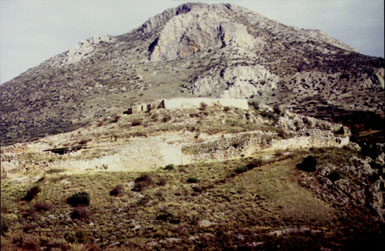
Link to Mycenae Plan
(Opens in a new window)

The primary remains at Mycenae are walls and tombs--the palace itself has largely been destroyed. No wonder Robert Payne was led to exclaim, "There is no escaping from the smell: the odour of corruption in the air. Except for the monolithic stones and the Gate of the Lionesses there is nothing remarkable here, no splendid courts, no spacious stairways . . . there is only rubble, and here and there the traces of the Dorian burning, and the open graves. And somehow it is very right. The menace is all the greater because it is never completely expressed. We are haunted by a presence which never reveals itself, but there is no doubting that it is there." (The Splendor of Greece, 1960, 26-27.)

Payne is right; it is appropriate that tombs and walls dominate at Mycenae, for this was the location of the mythological House of Atreus, cursed for generations because Atreus himself, in the final act of a dynastic struggle, fed his brother, Thyestes, his own children for dinner. Atreus's son, Agamemon, would be forced to sacrifice his daughter to gain favorable winds for the expedition to Troy--that successful but debilitating war from which the Mycenaeans would never recover. Agamemnon himself would not live to enjoy the spoils; his wife, Clytemnestra would kill him on his return. She, in turn, would be killed by her son, Orestes. Death has haunted Mycenae for a long time.
The walls strike one first.
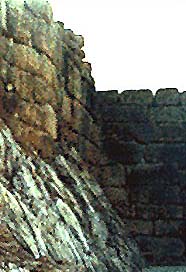
Later Greeks would describe these walls as Cyclopean, since they were built of stones so large only a Cyclops could move them.
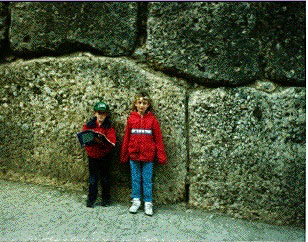
The name has stuck. There are, however, other distinctive types of wall construction at Mycenae. Polygonal walls (below left), with stones shaped to fit together, are visible, as is ashlar masonry (below right), with finely cut rectangular blocks.
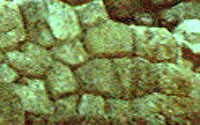
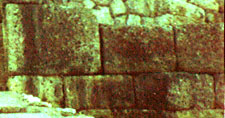
Massive defensive walls were typical at Mycenaen citadels--shown below is the wall at nearby Tiryns. (The palace of Nestor at Pylos is a notable exception.)
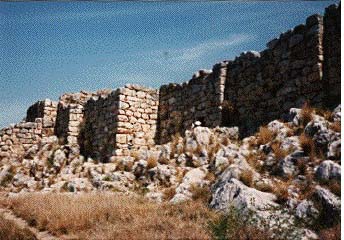
The road to Mycenae leads to the main gate, with its impressive lion relief. The Lion Gate represents the earliest large relief sculpture on the Greek mainland.
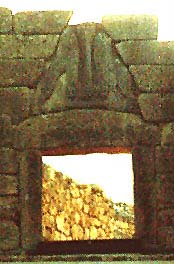

The walls at Mycenae were constructed in several stages, from late 15th century BCE to the end of the 13th century BCE. The earliest circuit encompassed the palace area, but the walls were extended (at the beginning of the 13th century BCE) to include the Lion gate and a burial area, grave circle A, in which Schliemann discovered a treasure in gold death masks, ceremonial weapons, and other grave goods. Grave circle A, dating from the 16th century BCE, appears to the right as one passes through the Lion gate. Here, looking back (the Lion Gate is the triangle in the wall in the upper right), one can see how the wall was extended to encompass the Grave Circle:
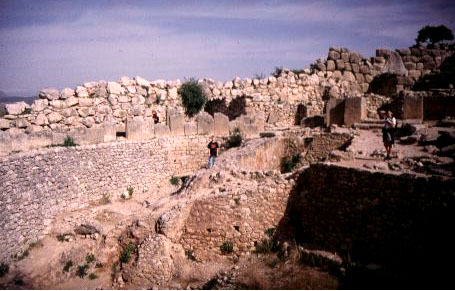
Schliemann uncovered a number of graves in the circle; the locations of some are evident here:
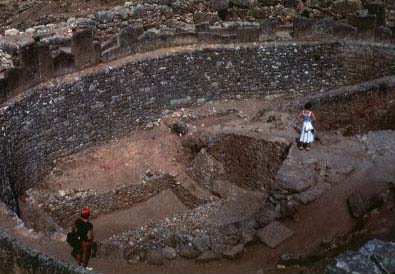
On the discovery of one death mask, Schliemann exclaimed that he had gazed upon the face of Agamemnon.
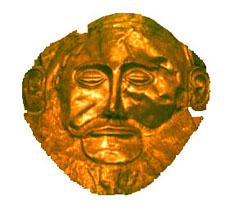
He would later discover, however, that grave circle A predated Agamemnon's era by about two hundred years. (More splendid burial sites, the tholos tombs, were discovered outside the citadel.)
As one looks down the hill from Grave Circle A, the walls again are evident, along with the foundations of buildings constructed close by the circle:
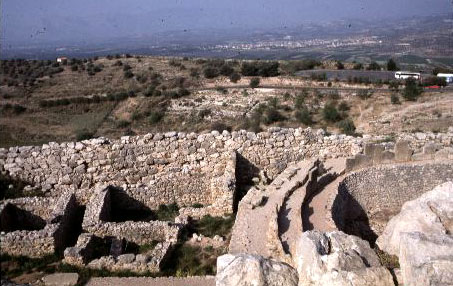
The road within the walls leads to the palace area near the summit. Here, the view is back toward the Lion Gate:
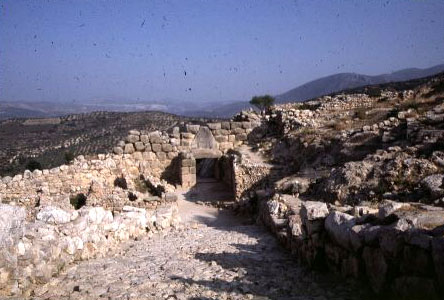
 Most of the palace has been lost. There is little left of the distinctive Mycenaean megaron with its circular hearth. The view below does highlight the locations of the columns that would have helped support the roof, with its opening above the hearth.
Most of the palace has been lost. There is little left of the distinctive Mycenaean megaron with its circular hearth. The view below does highlight the locations of the columns that would have helped support the roof, with its opening above the hearth.
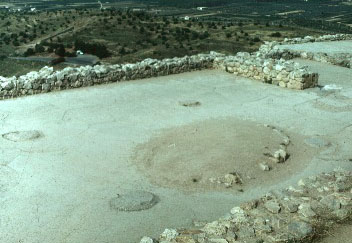
A well-preserved hearth remains at Pylos, another Mycenean site, the one recounted in Homer when Telemachus' journey to seek information about his father brought him to Nestor's palace at Pylos:
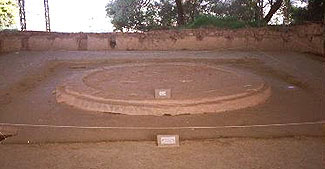
As one continues down past the palace area, to the far eastern end of the citadel, a water stair, cut into the rock, becomes visible. Built down to a spring-fed source, the stairway provided a secure source of water during a seige.
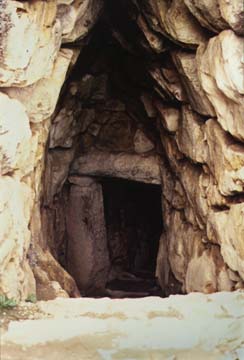

The protected water stairway begins close to the outer wall. Nearby, at the far end of the wall, is a sally port; this opening, difficult to locate from outside and easily defended from within, would have allowed scouting parties to survey the surrounding area in the event of a seige. (The second picture below looks through a similar sally port at Tiryns and gives some sense of the thickness of Mycenaean walls.)
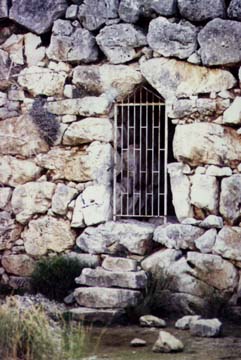
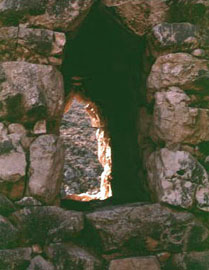
Following the outer wall back, one can view the postern gate.
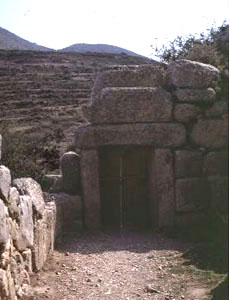

Though many houses and other buildings were encompassed within the citadel walls, others are evident outside the walls. In addition, scattered around the area are a number of tholos tombs--monumental burial structures that were built in the shape of a beehive. It is the later examples of these structures that would have been used during the time of the Homeric legends.
To the south of the citadel lies the tholos tomb Schliemann dubbed the Treasury of Atreus, built in the mid-13th century BCE. Note the finely cut blocks and the taper up to a capstone--not a keystone.
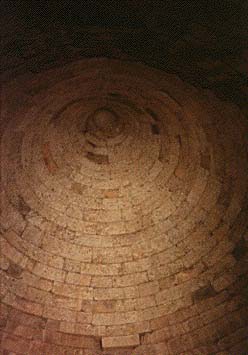
Such construction is described as corbelling, with each successive horizontal course laid inward from that below, until the area is closed off.
Note also the impressive entryway (dromos) to the tomb, with its ashlar masonry walls--and the corbelling technique over the doorway that resulted in what is now an open space, a relieving triangle, which decreased the weight on the lintel.
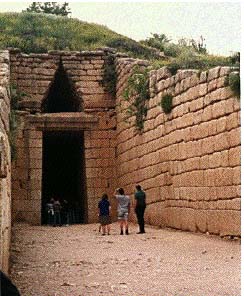
This technique was used in the Lion Gate as well. The carving of the lions was then placed within the open triangle left by the corbelled blocks; the technique is also evident in the hallway leading to storage rooms at Tiryns (right):
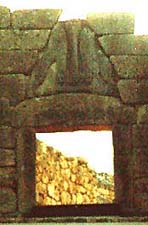
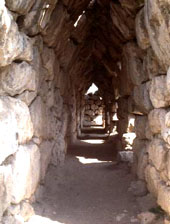
The Treasury of Atreus marks the culmination in the evolution of tholos tombs. The so-called Tomb of Clytemnestra, built very close to the citadel itself, is impressive but not quite as finely finished as the Treasury of Atreus.
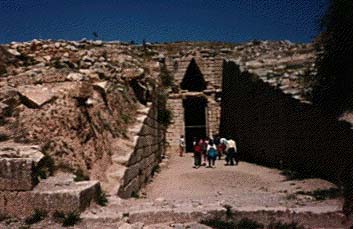
Tholos tombs were first used early in the 15th century BCE. Examples of early tombs are pictured below; note the rougher construction of (what is left of) the dromos walls and the doorway.

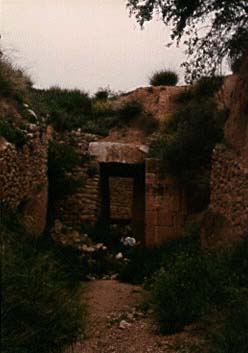
Unfortunately, the tholos tombs were robbed before archaeologists uncovered them. Given the splendid finds in grave circle A, one might have expected incredible treasures in the later and more elaborate tholos tombs.
One source of Mycenae's wealth is evident as one looks out from the citadel. Mycenae, perched on its hill, commands a large and fertile valley.
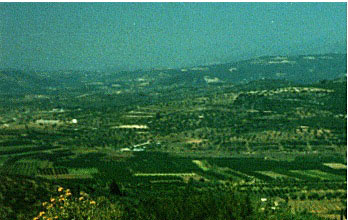
The image below provides a sense of the geography of the area. Looking from the citadel summit, with Mycenae's walls below, one sees the Plain of Argos extend before the citadel. A tip of the Bay of Argos is visible in the upper left. In the distance is the range of mountains that would have provided some insulation against external invasion or migration:
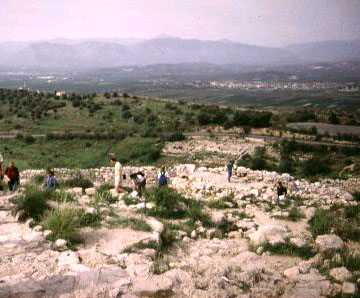
The original purpose of the Mycenaean citadel walls is still debated. Though they may ultimately have served a defensive purpose, the walls may originally have been constructed more as a show of strength. As the Mycenaean Age proceeded, however, it is clear that the residents of these citadels faced serious threats, which eventually led to the destruction of the Mycenaean centers. The cause of the destruction remains unclear. But whatever the threat, even the cyclopean walls proved inadequate defense.